List of battleships of Japan

In the late 19th century, the strategy of the Imperial Japanese Navy (IJN) was based on the Jeune Ecole naval philosophy, promoted by French military advisor and naval architect Emile Bertin. This emphasized cheap torpedo boats and commerce raiding to offset expensive, heavily armoured ships. However, the acquisition of two German-built Dingyuan-class ironclads by the Imperial Chinese Beiyang Fleet in 1885 threatened Japan's interests in Korea. A visit by the Chinese warships to Japan in early 1891 forced the Japanese government to acknowledge that the IJN required similarly armed and armoured ships of its own to counter the ironclads; the three lightly armored Matsushima-class cruisers ordered from France would not suffice, despite their powerful guns. The IJN decided to order a pair of the latest battleships from the United Kingdom as Japan lacked the technology and capability to construct its own battleships.[2][3]
Combat experience in the First Sino-Japanese War of 1894–95 convinced the IJN that the Jeune Ecole doctrine was untenable. Therefore, Japan promulgated a ten-year naval build-up in early 1896, to modernize and expand its fleet in preparation for further conflicts, with the construction of a total of six battleships and six armored cruisers at its core.[4] These ships were provided for from the £30,000,000 indemnity paid by China after losing the First Sino-Japanese War and the four remaining battleships of the program were also built in the UK.[5]
Rising tensions between the Japanese and the Russian Empire over control of Korea and Manchuria in the early 1900s caused the former to begin the Russo-Japanese War in 1904 with a surprise attack on the Russian base at Port Arthur. The Imperial Japanese Army captured the port, and the surviving ships of the Russian Pacific Squadron by the end of the year, but the Russians had dispatched the bulk of their Baltic Fleet to relieve Port Arthur before then. It did not reach the Korea Strait until May 1905 and was virtually annihilated by the IJN in the Battle of Tsushima despite significantly outnumbering the Japanese. During the war, Japan captured a total of six Russian pre-dreadnoughts. These were all repaired and commissioned into the Japanese fleet; of these, three were later returned to Russia during World War I, as the two countries were by then allies. The magnitude of the victory at Tsushima caused the leadership of the IJN to believe that a surface engagement between the main fleets was the only decisive battle in modern warfare and would be decided by battleships armed with the largest guns. The corollary to this was that Japanese ships had to be qualitatively superior to those of their opponents to ensure victory.[6]
After the war, the Japanese Empire immediately turned its focus to the two remaining rivals for imperial dominance in the Pacific Ocean: Britain and the United States.[7] Satō Tetsutarō, an IJN admiral and military theorist, speculated that conflict would inevitably arise between Japan and at least one of its two main rivals. To that end, he called for the IJN to maintain a fleet with at least 70% as many capital ships as the US Navy. This ratio, Satō theorized, would enable the Imperial Japanese Navy to defeat the US Navy in one major battle in Japanese waters in any eventual conflict. Accordingly, the 1907 Imperial Defense Policy called for the construction of a battle fleet of eight modern battleships, 20,000 long tons (20,321 t) each, and eight modern armored cruisers, 18,000 long tons (18,289 t) each.[8] This was the genesis of the Eight-Eight Fleet Program, the development of a cohesive battle line of sixteen capital ships.[9]
The launch of HMS Dreadnought in 1906 by the Royal Navy raised the stakes,[10] and complicated Japan's plans as she rendered all existing battleships obsolete.[11] The launch of the battlecruiser HMS Invincible the following year was a further setback for Japan's quest for parity. When the two new Satsuma-class battleships and two Tsukuba-class armored cruisers, launched by 1911, were outclassed by their British counterparts, the Eight-Eight Fleet Program was restarted.[12]
The first battleships built for the renewed Eight-Eight Fleet Program were the two dreadnoughts of the Kawachi class, ordered in 1907 and laid down in 1908. In 1910, the Navy put forward a request to the Diet) to secure funding for the entirety of the program at once. Because of economic constraints, the proposal was cut first by the Navy Ministry to seven battleships and three battlecruisers, then by the cabinet to four armored cruisers and a single battleship. The Diet amended this by authorizing the construction of four battlecruisers (the Kongō class) and one battleship, later named Fusō, in what became the Naval Emergency Expansion bill.[13]
| Armament | The number and type of the primary armament |
|---|---|
| Armor | The thickness of the belt armor |
| Displacement | Ship displacement at normal load |
| Propulsion | Number of shafts, type of propulsion system, and top speed generated |
| Service | The dates work on the ship began and finished and its ultimate fate |
| Laid down | The date the keel began to be assembled |
| Commissioned/Captured | The date the ship was commissioned or captured |
Pre-Dreadnoughts
Fuji class

The two Fuji-class (Kanji: 富士型戦艦; Rōmaji: Fuji-gata) battleships, Fuji and Yashima, were the Imperial Japanese Navy's first battleships, ordered in response to two new German-built Chinese ironclad warships. The Fuji sisters were designed as smaller a version of the Royal Sovereign-class, but were smaller at 12,230–12,533 long tons (12,426–12,734 t) displaced and 412 feet (126 m) in length. They were protected by a 14–18 in (356–457 mm) waterline belt of Harvey armor and were armed with four 12-inch (305 mm) main guns,[14] sixteen 6-inch (152 mm) guns,[15] twenty-four Hotchkiss guns, and five torpedo tubes.[16] Two Humphrys Tennant vertical triple-expansion steam engines, turning one shaft each, gave Japan's first battleships a top speed of 18.25 kn (33.80 km/h; 21.00 mph).[17]
Both Fuji-class battleships began construction in the second half of 1894,[18] but Yashima was finished and arrived in Japan the year before Fuji,[19] who participated in the fleet review for Queen Victoria's Diamond Jubilee on 26 June 1897.[20] As part of the 1st Fleet the sisters participated in fighting off Port Arthur on 9–10 March 1904, wherein Fuji sustained light damage and Yashima was unmarred,[21] and then in the action of 13 April that resulted in the destruction of the Russian battleship Petropavlovsk.[22] On 15 May 1904, Yashima struck two naval mines and was foundered, leaving Fuji as the only remaining Fuji-class battleship.[15] She went on to, in August, participate in the Battle of the Yellow Sea without damage and then in the Battle of Tsushima in May 1905,[23] where she is credited with the shot that caused the magazine explosion that destroyed Borodino, and again only incurred minor damage.[24] On 23 October 1908, Fuji hosted the American ambassador to Japan and some senior officers of the Great White Fleet,[25] and was reduced to a coastal defense vessel, later being totally disarmed, until being sunk by American aircraft on 18 July 1945 and was scrapped in 1948.[26]
| Ship | Armament | Armor | Displacement | Propulsion | Service | ||
|---|---|---|---|---|---|---|---|
| Laid down | Commissioned | Fate | |||||
| Fuji (富士) |
4 × 12 in (305 mm)[27] | 18 in (460 mm)[16] | 12,533 long tons (12,734 t)[15] | 2 shafts, 2 steam engines, 18.25 kn (33.80 km/h; 21.00 mph)[17] | 1 August 1894[28] | 17 August 1897[18] | Broken up, 1948[18] |
| Yashima (八島) |
6 December 1894[29] | 9 September 1897[18] | Foundered after striking a mine, 15 May 1904[15] | ||||
Shikishima class
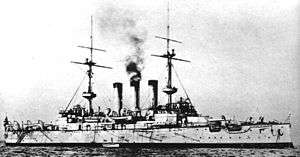
The Shikishima-class (Kanji: 敷島型戦艦; Rōmaji: Shikishima-gata senkan) sisters, Shikishima and Hatsuse, were designed as a more powerful version of the Royal Navy's Majestic-class battleship and were built in England.[30] As with the Majestic and Fuji-classes, the Shikishima sisters were armed with four 12-inch (305 mm) main guns,[31] fourteen 6-inch (152 mm) guns,[32] twenty 12-pound guns, four Hotchkiss guns, and four torpedo tubes.[5] The sisters were also powered by the same method; two Humphrys Tennant vertical triple-expansion steam engines, their two shafts, and a top speed of 18 kn (33 km/h; 21 mph). The Shikishima-class's 4–9 inches (102–229 mm) Harvey belt armor was half as thick as that of the Fuji-class and the sisters were as long as the Majestic-class at 412 feet (126 m), they had an increased displacement of 14,850–15,000 long tons (15,090–15,240 t).[33]
Shikishima was completed on 26 June 1900 and immediately departed England for Japan, but Hatsuse stayed in England after her completion on 18 January 1901 to represent Emperor Meiji at Queen Victoria's funeral.[34][35] Assigned to the 1st Fleet before the Russo-Japanese War, the sisters were present at the Battle of Port Arthur and both Shikishima sisters were hit three times between them. The sisters were also present for the destruction of Russian admiral Makarov's flagship Petropavlovsk,[36] but Hatsuse struck one of the mines that the Russians laid following Makarov's death and was sunk following a magazine explosion.[37] Shikishima carried on as the only remaining vessel of her class and fought in the Battle of the Yellow Sea, only being damaged by a misfiring 12-inch (305 mm) shell,[38] and then participated in the Battle of Tsushima on 27–28 May 1905 where she was hit nine times, suffered another misfire from one of her main guns, and sank the Russian battleship Oslyabya with the Mikasa.[39] Shikishima spent the duration of First World War at the Sasebo Naval District,[40] and was reclassified twice after the Washington Naval Treaty was signed in 1922.[34] She was used as a training hulk at Sasebo until 1948, when she was broken up.[41]
| Ship | Armament | Armor | Displacement | Propulsion | Service | ||
|---|---|---|---|---|---|---|---|
| Laid down | Commissioned | Fate | |||||
| Shikishima (敷島) |
4 x 12 in (305 mm)[31] | 9 in (230 mm)[42] | 14,850 long tons (15,090 t)[5] | 2 shafts, 2 steam engines, 18 kn (33 km/h; 21 mph)[5] | 29 March 1897[41] | 26 January 1900[41] | Broken up, January 1948[41] |
| Hatsuse (初瀬) |
10 January 1898[43] | 18 January 1901[34] | Sank 15 May 1904, after striking two mines[34] | ||||
Asahi
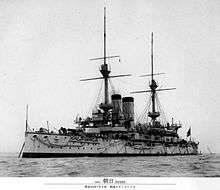
Asahi (Kanji: 朝日) was built in the 1890s as a modified version of the British Formidable-class battleships,[40] but she displaced 15,200 long tons (15,400 t). As with previous Japanese battleships, the 425 feet 3 inches (130 m) long Asahi was powered by two Humphrys, Tennant and Dykes vertical triple-expansion steam engines and two shafts for a top speed of 18 kn (33 km/h; 21 mph).[34] Like previous Japanese battleships, she had four 12-inch (305 mm) main guns,[31] fourteen 6-inch (152 mm) guns,[34] twenty 12-pound guns,[44] a total of twelve Hotchkiss guns,[45] and four torpedo tubes.[40] Asahi retained the 4–9-inch (100–230 mm) thick Harvey belt armor of the Shikishima-class.[31][46]
Following her completion, Asahi arrived at Yokosuka on 23 October 1900 and the next year she became the flagship of the Imperial Japanese Navy's Standing Fleet and was later assigned to the 1st Fleet when the Combined Fleet reformed on 23 December 1903.[47][48] At the start of the Russo-Japanese War, Asahi took part in the Battle of Port Arthur and the destruction of the Russian battleship Petropavlovsk and was undamaged in both actions. At the Battle of the Yellow Sea, Asahi suffered moderate damage but damaged the Poltava and the Tsesarevich.[49] Asahi struck a mine two months later near Port Arthur, but was repaired in time for the Battle of Tsushima. There, she helped disable the Knyaz Suvorov and dueled with the Borodino and the Oryol, taking no damage.[50]
She was a gunnery training ship for most of World War I until being rearmed in 1917 in time to escort troop transports during Japan's intervention in the Russian Civil War.[34] Asahi was again retrofitted into a noncombat vessel during the 1920s and then made a repair ship on 16 August 1937,[48] but also transported Imperial Army troops to Hangzhou Bay. On the night of 25-26 May 1942, Asahi was torpedoed and sunk by USS Salmon off modern-day Vietnam.[47]
| Ship | Armament | Armor | Displacement | Propulsion | Service | ||
|---|---|---|---|---|---|---|---|
| Laid down | Commissioned | Fate | |||||
| Asahi (朝日) |
4 × 12 in (305 mm)[31] | 9 in (229 mm)[46] | 15,200 long tons (15,400 t)[34] | 2 shafts, 2 steam engines, 18 kn (33 km/h; 21 mph)[51][34] | 1 August 1897[52] | 31 July 1900[48] | Sunk by USS Salmon, 25–26 May 1942[47] |
Mikasa

Mikasa (Kanji: 三笠) was a modified version of the Royal Navy's Formidable-class battleship.[40] She had a nearly identical length of 432 feet (132 m),[34] the same 40-caliber 12-inch (300 mm) main guns used on the Formidable-class and all preceding Japanese battleships,[31] and 4–9 inches (102–229 mm) of Krupp armour on her belt.[44] She also retained the two steam engines and their shafts, but was faster at a top speed of 18.45 kn (34.17 km/h; 21.23 mph). Like Asahi, Mikasa had two more of her secondary 6-inch (152 mm) guns than Formidable for a total of 14, and had a similar displacement of 15,140 long tons (15,380 t).[53]
| Ship | Armament | Armor | Displacement | Propulsion | Service | ||
|---|---|---|---|---|---|---|---|
| Laid down | Commissioned | Fate | |||||
| Mikasa (三笠) |
4 × 12 in (305 mm)[31] | 9 in (229 mm)[44] | 15,140 long tons (15,380 t)[34] | 2 shafts, 2 steam engines, 18.45 kn (34.17 km/h; 21.23 mph)[53] | 24 January 1899[54] | 1 March 1902[54] | Preserved as a museum ship[55] |
Tango
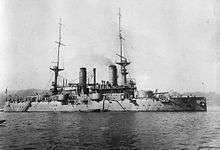
The Tango (Kanji: 丹後) was originally laid down as the Russian battleship Poltava (Russian: Полтава), the second of three Petropavlovsk-class pre-dreadnought battleships built for the Imperial Russian Navy in the 1890s. She was armed with four 12 in (305 mm) main guns, twelve 6 in (152 mm) guns, twelve 47 mm (1.9 in) Hotchkiss guns, twenty-eight 37 mm (1 in) autocannons, six torpedo tubes, and 50 mines. Her 376 ft (115 m) long hull was protected by a Krupp armour belt 12–14.5 inches (305–368 mm) thick. Finally, Tango had two Humphrys, Tennant and Dykes-built vertical triple-expansion steam engines driving one shafts each for a top speed of 16 kn (30 km/h; 18 mph).[56]
Laid down on 19 May 1892 and launched on 6 November 1894, Poltava was assigned to the Pacific Squadron shortly after her completion and based at Port Arthur from 1901.[57] During the Russo-Japanese War, she participated in the Battle of Port Arthur and was heavily damaged during the Battle of the Yellow Sea.[58][59] Sunk by Japanese artillery during the subsequent Siege of Port Arthur in December 1904, she was raised by the Imperial Japanese Navy after the war and subsequently renamed Tango.[60][61] During World War I, she bombarded German fortifications during the Siege of Tsingtao.[62] The Japanese government sold Tango back to the Russians at their request in 1916. She was renamed Chesma (Чесма) as her former name had been given to a new ship.[61][63] En route to the White Sea, she joined an Allied force that persuaded the Greek government to disarm their ships.[64] Her crew declared for the Bolsheviks in October 1917,[65] but made no effort to resist when the British decided to intervene in the Russian Civil War in early 1918.[66] In poor condition, the ship was used as a prison hulk. Abandoned by the British when they withdrew in 1919 and recaptured by the Bolsheviks, she was scrapped in 1924.[63]
| Ship | Armament | Armor | Displacement | Propulsion | Service | ||
|---|---|---|---|---|---|---|---|
| Laid down | Captured | Fate | |||||
| Tango (丹後) |
4 × 12 in (300 mm) [67] | 12–14.5 in (300–370 mm) Krupp armor[67] | 11,500 long tons (11,700 t)[67] | 2 shafts, 2 steam engines, 16 kn (30 km/h; 18 mph)[67] | 19 May 1892[68] | 2 January 1905[69] | Returned to Russia, 1916,[70] scrapped, 1924[63] |
Sagami and Suwo

The battleships Sagami (Kanji: 相模) and Suwo (周防), originally the Imperial Russian Peresvet-class battleships Peresvet (Russian: Пересвет) and Pobeda (Победа), were laid down in 1895 and 1899 respectively.[71] The Peresvet sisters were 343 feet (105 m) long and displaced 13,320–14,408 long tons (13,534–14,639 t), powered by three vertical triple-expansion steam engines driving one shaft each, giving them a top speed of 18 kn (33 km/h; 21 mph). The sisters were armed with four 10 in (254 mm), eleven 6 in (152 mm) guns, twenty 75 mm (3 in), twenty 47 mm (2 in) Hotchkiss guns, eight 37 mm (1 in) guns, five torpedo tubes, and forty-five mines. The two sisters used Krupp armor for their belts, 9 inches (229 mm) thick.[72]
| Ship | Armament | Armor | Displacement | Propulsion | Service | ||
|---|---|---|---|---|---|---|---|
| Laid down | Captured | Fate | |||||
| Sagami (相模) |
2 × 10 in (254 mm)[73] | 9 in (229 mm)[73] | 13,810 long tons (14,030 t)[73] | 2 shafts, 2 steam engines, 18 kn (33 km/h; 21 mph)[73] | 21 November 1895[71] | 2 January 1905[74] | Struck a mine off Port Said, Egypt, 4 January 1917[75] |
| Suwo (周防) |
13,320 long tons (13,530 t)[73] | 21 February 1899[76] | 2 January 1905[77] | Probably scrapped, 1922–23[78] | |||
Hizen
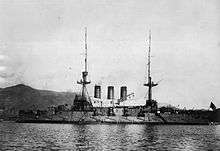
Hizen (Kanji: 肥前), originally Retvizan (Russian: Ретвизан), was an Imperial Russian pre-dreadnought battleship built from 1899 to 1902. She had a top speed of 18 kn (33 km/h; 21 mph) despite a displacement of 12,708 long tons (12,912 t), supplied by two vertical triple expansion engines powering a shaft each. The 382 ft 3 in (117 m) long ship was protected by an armor belt of 9 inches (229 mm) of Krupp armor and was armed with 12 in (305 mm) main guns, twelve 6 in (152 mm) guns, twenty-four 47 mm (2 in) Hotchkiss guns, six 37 mm (1 in) guns, six torpedo tubes, and forty-five mines.[79]
| Ship | Armament | Armor | Displacement | Propulsion | Service | ||
|---|---|---|---|---|---|---|---|
| Laid down | Captured | Fate | |||||
| Hizen (肥前) |
4 × 12 in (305 mm)[80] | 9 in (229 mm)[81] | 12,780 long tons (12,985 t)[82] | 2 shafts, 2 steam engines, 18 kn (33 km/h; 21 mph)[82] | 29 July 1899[83] | 2 January 1905[84] | Sunk as a target ship, 25 July 1924[84] |
Iwami
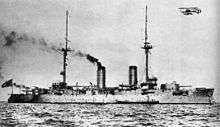
Iwami (Kanji: 石見) was originally built in the first decade of the 20th century for the Imperial Russian Navy as the pre-dreadnought battleship Oryol (Russian: Орёл). As the Iwami, she was armed with four 12 in (305 mm) main guns, eight 8 in (203 mm) guns, sixteen 76.2 mm (3 in) guns, four 47 mm (2 in) guns, and two torpedo tubes. Iwami was powered by two triple expansion steam engines driving one shaft each for a top speed of 18 kn (33 km/h; 21 mph). She was protected by a Krupp belt 5.7–7.64 inches (145–194 mm) thick, altogether giving the 397 ft (121 m) long Iwami a displacement of 14,151 long tons (14,378 t).[85]
| Ship | Armament | Armor | Displacement | Propulsion | Service | ||
|---|---|---|---|---|---|---|---|
| Laid down | Captured | Fate | |||||
| Iwami (石見) |
4 × 12 in (305 mm)[86] | 7.64 in (194 mm)[87] | 14,151 long tons (14,378 t)[88] | 2 shafts, 2 steam engines, 18 kn (33 km/h; 21 mph)[89] | 1 June 1900[88] | 28 May 1905[90] | Sunk as a target ship, 10 July 1924,[91] |
Katori class
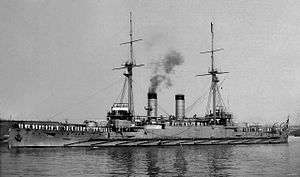
The Katori-class consisted of two pre-dreadnought battleships, Katori and Kashima, and were the last of Japan's battleships to be built overseas.[92] They were built on a modified plan of the British King Edward-class battleships, sharing a pair of vertical triple expansion steam engines turning a shaft each, but with a top speed of 18 kn (33 km/h; 21 mph). Beyond a shared 9 inches (229 mm) of Krupp armor on their belts, the sisters differ in some key areas. Katori displaced 15,950 long tons (16,210 t), was 456 feet 3 inches (139 m) long, and was armed with four 46.7-caliber 12 in (305 mm) main guns, four 10 in (254 mm) guns of the same caliber, twelve 6 in (152 mm) guns, and twelve 3 in (76 mm) guns. Kashima was 473 feet 7 inches (144 m) long, displaced 16,400 long tons (16,700 t), and wielded four 45-caliber 12 in main guns, four 10 in and 6 in guns of the same caliber, and sixteen 3 in guns. Both had the same three 47 mm (1.9 in) Hotchkiss guns and five torpedo tubes.[93][94]
Both ships were completed in May 1906, after the conclusion of the Russo-Japanese War. While they saw no action during World War I, the ships of the Katori-class were both present for Japan's intervention in Siberia in 1918.[95][96] In 1921, the sisters carried Crown Prince Hirohito on his tour of Europe where he met King George V.[97] Under the terms of the Washington Naval Treaty of 1922 however, both ships were disarmed and scrapped between 1923–25.[98]
| Ship | Armament | Armor | Displacement | Propulsion | Service | ||
|---|---|---|---|---|---|---|---|
| Laid down | Commissioned | Fate | |||||
| Katori (香取) |
4 × 12 in (305 mm)[99] | 9 in (229 mm)[99] | 15,950 long tons (16,210 t)[93] | 2 shafts, 2 steam engines, 18 kn (33 km/h; 21 mph)[93] | 27 April 1904[100] | 20 May 1906[100] | Sold for scrap, April 1924[96] |
| Kashima (鹿島) |
16,400 long tons (16,700 t)[93] | 29 February 1904[100] | 23 May 1906[100] | Broken up, 1924–25[101] | |||
Satsuma class
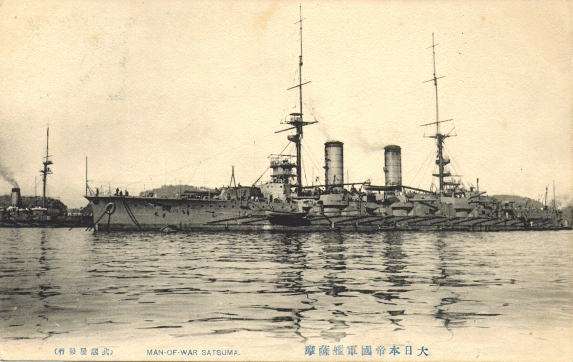
The Satsuma-class battleships, Satsuma (Kanji: 薩摩) and Aki (安芸), were the first battleships to be built in Japan. They marked a transitional stage in battleship,[102] as the sisters were intended to mount a dozen 12-inch (305 mm) guns. Material shortages in Japan and the expense of construction led to a redesign that armed the sisters with four 12-inch (305 mm) and twelve 10-inch (254 mm) guns.[103] If built as planned, the Satsuma-class would have been the world's first "all big-gun" battleships.[92] They were protected by 9 inches (230 mm) of Krupp armor on their belts and armed with the same four 12 in main guns, 10 in secondary guns, and five torpedo tubes.[104][103]
Satsuma, 482 feet (147 m) long, was powered traditionally with two vertical triple-expansion engines and two shafts, giving her a top speed of 18.5 kn (34.3 km/h; 21.3 mph) despite a displacement of 19,372 long tons (19,683 t). The rest of her armament was composed of twelve 4.7 in (119 mm) guns, and eight 3.1 in (79 mm) guns. Aki was longer, at 492 feet (150 m), and heavier at 20,100 long tons (20,400 t). She was also powered by two steam turbines and two shafts, giving her a top speed of 20 kn (37 km/h; 23 mph). Aki's secondary armament was made up by eight 6 in (152 mm) guns, and twelve 3.1 in guns.[104]
The introduction of the HMS Dreadnought in 1906 ensured that the Satsuma-class were obsolete before they were even launched. Nevertheless, Aki was launched on 15 November 1906, while Satsuma followed on 15 April 1907.[105] Satsuma would go on to serve as Rear Admiral Tatsuo Matsumura's flagship in the Second South Seas Squadron as it seized the German possessions of the Caroline and the Palau Islands in October 1914 in the opening months of World War I. Satsuma would later be refitted at Sasebo Naval Arsenal in 1916 and served with the 1st Squadron for the rest of the war. Aki was also assigned to the 1st Squadron until she was transferred to the 2nd Battleship Squadron in 1918.[92] Both ships were sunk as targets by the Nagato and Mutsu under the terms of the Washington Naval Treaty in 1924.[106]
| Ship | Armament | Armor | Displacement | Propulsion | Service | ||
|---|---|---|---|---|---|---|---|
| Laid down | Commissioned | Fate | |||||
| Satsuma (薩摩) |
4 × 12 in (305 mm) 12 x 10 in (254 mm)[104] |
9 in (229 mm)[104] | 19,372 long tons (19,683 t)[104] | 2 shafts, 2 steam engines, 18.5 kn (34.3 km/h; 21.3 mph)[104] | 15 May 1905[41] | 25 March 1910[41] | Sunk as a target ship, 7 September 1924[41] |
| Aki (安芸) |
20,100 long tons (20,400 t)[104] | 2 shafts, 2 steam turbine sets, 20 kn (37 km/h; 23 mph)[104] | 15 March 1906[41] | 11 March 1911[41] | Sunk as a target ship, 2 September 1924[41] | ||
Dreadnought battleships
Kawachi class
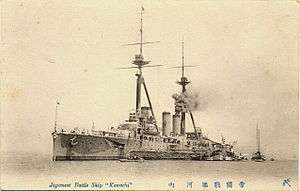
The Kawachi-class (Kanji: 河内型戦艦; Rōmaji: Kawachi-gata senkan), Kawachi (河内) and Settsu (摂津), were a pair of battleships ordered on 22 June 1907 under the Japan's Warship Supplement Program after the Russo-Japanese War.[107] They were the first dreadnought battleships of the Imperial Japanese Navy and marked one of the first steps in achieving Japan's recently adopted Eight-Eight Fleet Program, which called for a navy of eight dreadnoughts and eight armored cruisers.[108] The Kawachi-class sisters were armed with four 50-caliber 12 in (300 mm) and eight 45-caliber 12 in (300 mm) main guns,[109] arranged in the hexagonal layout used by the German dreadnoughts of the Nassau and Helgoland classes.[13] The rest of the armament was made up of ten 6 in (150 mm) secondary guns, eight 4.7 in (120 mm) guns, twelve 3.1 in (79 mm) guns, four 3 in (76 mm) saluting guns,[109] and five torpedo tubes.[110] The Kawachi sisters had a top speed of 18 kn (33 km/h; 21 mph), supplied by two steam turbines turning a shaft each. They were 576 feet (176 m) long, displaced 20,823–21,443 long tons (21,157–21,787 t),[109] and were protected by 12 inches of Krupp armor on their Belt armor.[111]
Settsu and Kawachi were laid down on 18 January and 1 April 1909 respectively. Kawachi was launched on 15 October 1910, while Settsu followed on 30 March 1911. Both ships were commissioned into the Japanese Navy in 1912.[112] Both ships bombarded German fortifications at Tsingtao during the Battle of Tsingtao in 1914, but saw no other combat in World War I. Kawachi sank in 1918 after an explosion in her ammunition magazine with the loss of over 600 officers and crewmen. Settsu was disarmed in 1922 under the terms of the Washington Naval Treaty and converted into a target ship. She was heavily damaged in 1945 by American carrier aircraft and eventually beached to avoid sinking. The ship was subsequently scrapped between 1946 and 1947.
| Ship | Armament | Armor | Displacement | Propulsion | Service | ||
|---|---|---|---|---|---|---|---|
| Laid down | Commissioned | Fate | |||||
| Kawachi (河内) |
12 × 12 in (300 mm)[109] | 12 in (300 mm)[109] | 20,823 long tons (21,157 t)[109] | 2 shafts, 2 steam turbines, 21 kn (39 km/h; 24 mph)[109] | 1 April 1909[112] | 31 March 1912[112] | Sunk by magazine explosion, 12 July 1918[112] |
| Settsu (摂津) |
21,443 long tons (21,787 t)[109] | 18 January 1909[112] | 30 March 1911[112] | Scrapped, 1946–47[112] | |||
Fusō class

| Ship | Armament | Armor | Displacement | Propulsion | Service | ||
|---|---|---|---|---|---|---|---|
| Laid down | Commissioned | Fate | |||||
| Fusō | 12 × 14 in (360 mm) /45 guns[112] | 12 in[112] | 28,863 long tons (29,326 t)[113] | 4 shafts, 4 steam turbines, 22.5 kn (41.7 km/h; 25.9 mph)[112] | 11 March 1912[114] | 8 November 1915[114] | Sunk during the Battle of Surigao Strait, 25 October 1944[112] |
| Yamashiro | 20 November 1913[115] | 31 March 1917[115] | |||||
Ise class
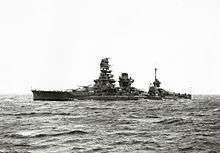
| Ship | Armament | Armor | Displacement | Propulsion | Service | ||
|---|---|---|---|---|---|---|---|
| Laid down | Commissioned | Fate | |||||
| Ise | 12 × 14 in /45 guns[116] | 12 in[116] | 30,770 long tons (31,260 t)[116] | 4 shafts, 4 steam turbines, 23 kn (43 km/h; 26 mph)[116] | 10 May 1915[117] | 15 December 1917[117] | Sunk, 28 July 1945[116] |
| Hyūga | 6 May 1915[117] | 30 April 1918[117] | Sunk, 24 July 1945[116] | ||||
Nagato class
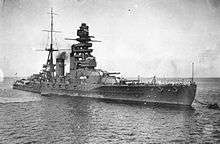
| Ship | Armament | Armor | Displacement | Propulsion | Service | ||
|---|---|---|---|---|---|---|---|
| Laid down | Commissioned | Fate | |||||
| Nagato | 8 × 41 cm (16 in) /45 guns[118] | 12 in Vickers cemented armor[118] | 32,720 long tons (33,250 t)[118] | 4 shafts, 4 steam turbines, 26 kn (48 km/h; 30 mph)[118] | 28 August 1917[119] | 25 November 1920[119] | Sunk during Operation Crossroads, 29/30 July 1946[118] |
| Mutsu | 1 June 1918[119] | 24 October 1921[119] | Sunk by internal explosion, 8 June 1943[118] | ||||
Tosa class

| Ship | Armament | Armor | Displacement | Propulsion | Service | ||
|---|---|---|---|---|---|---|---|
| Laid down | Commissioned | Fate | |||||
| Tosa | 10 × 41 cm /45 guns[120] | 11 in (280 mm) Vickers cemented armor[120] | 39,300 long tons (39,900 t)[120] | 4 shafts, 4 steam turbines, 26.5 kn (49.1 km/h; 30.5 mph)[120] | 16 February 1920[120] | — | Scuttled, 9 February 1925[121] |
| Kaga | 19 July 1920[120] | 31 March 1928[120] | Converted into an aircraft carrier, sunk during the Battle of Midway, 4 June 1942[120] | ||||
Kii class
| Ship | Armament | Armor | Displacement | Propulsion | Service | ||
|---|---|---|---|---|---|---|---|
| Laid down | Commissioned | Fate | |||||
| Kii | 10 × 41 cm /45 guns[120] | 292 mm (11.5 in)[120] | 41,900 long tons (42,600 t)[120] | 4 shafts, 4 steam turbines, 29.75 kn (55.10 km/h; 34.24 mph)[120] | — | — | — |
| Owari | |||||||
| No. 11 | |||||||
| No. 12 | |||||||
Number 13 class

| Ship | Armament | Armor | Displacement | Propulsion | Service | ||
|---|---|---|---|---|---|---|---|
| Laid down | Commissioned | Fate | |||||
| No. 13 | 8 × 45.7 cm (18.0 in) /45 guns[122] | 330 mm (13 in)[122] | 46,700 long tons (47,500 t)[122] | 4 shafts, 4 steam turbines, 30 kn (56 km/h; 35 mph)[122] | — | — | — |
| No. 14 | |||||||
| No. 15 | |||||||
| No. 16 | |||||||
Yamato class
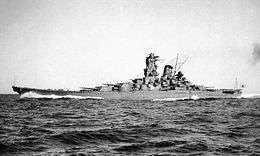
| Ship | Armament | Armor | Displacement | Propulsion | Service | ||
|---|---|---|---|---|---|---|---|
| Laid down | Commissioned | Fate | |||||
| Yamato | 9 × 46 cm (18.1 in) /45 guns[123] | 410 mm (16 in) Vickers Hardened[123] | 61,331 long tons (62,315 t)[123] | 4 shafts, 4 steam turbines, 27 kn (50 km/h; 31 mph)[123] | 4 November 1937[123] | 16 December 1941[123] | Sunk in air attack, 7 April 1945[123] |
| Musashi | 29 March 1938[123] | 5 August 1942[123] | Sunk in air attack, 24 October 1944[123] | ||||
| Shinano | 4 May 1940[123] | 19 November 1944[123] | Converted to an aircraft carrier, sunk 28 November 1944[124] | ||||
| No. 111 | 7 July 1940[123] | — | — | ||||
Design A-150
"Design A-150", popularly known as the Super Yamato-class, was a planned class of battleships that would have succeeded the Yamato-class. In keeping with the IJN's long tradition, they were designed to be qualitatively superior to battleships that might be faced in battle, such as those from the United States or Great Britain. As part of this, the class would have been armed with six 51 cm (20 in) guns, the largest weapons carried aboard any warship in the world. Design work on the A-150s began after the preceding Yamato-class was mostly finished by early 1941, when the Japanese began focusing on aircraft carriers and other smaller warships in preparation for the coming conflict. No A-150 would ever be laid down, and many details of the class' design were destroyed near the end of the war.
| Ship | Armament | Armor | Displacement | Propulsion | Service | ||
|---|---|---|---|---|---|---|---|
| Laid down | Commissioned | Fate | |||||
| No. 798 | 6 × 51 cm (20 in) /45 guns[125] | Probably 457 mm[123] | Approximately 70,000 long tons (71,000 t)[126] | Unknown | — | — | — |
| No. 799 | |||||||
See also
| Wikimedia Commons has media related to Battleships of Japan. |
Notes
- ↑ All figures are for the ship as completed.
Citations
- ↑ Combined Fleet: Yamato.
- ↑ Evans & Peattie 1997, pp. 15, 19–20, 60.
- ↑ Brook 1999, p. 123.
- ↑ Evans & Peattie 1997, pp. 15, 57–60.
- 1 2 3 4 Brook 1999, p. 125.
- ↑ Evans & Peattie 1997, pp. 85–86, 110, 116–32.
- ↑ Stille 2008, p. 4.
- ↑ Evans & Peattie 1997, pp. 143, 150.
- ↑ Stille 2008, p. 7.
- ↑ Evans & Peattie 1997, p. 152.
- ↑ Sandler 2004, p. 90.
- ↑ Evans & Peattie 1997, p. 154, 159.
- 1 2 Evans & Peattie 1997, p. 160.
- ↑ Lengerer 2009, p. 27.
- 1 2 3 4 Jentschura, Jung & Mickel 1977, p. 16.
- 1 2 Brook 1999, p. 122.
- 1 2 Lengerer Japanese Battleships and Battlecruisers – Part II, pp. 23, 27.
- 1 2 3 4 Jentschura, Jung & Mickel 1977, p. 17.
- ↑ Lengerer Japanese Battleships and Battlecruisers – Part II, p. 14.
- ↑ Dorset Echo, 3 January 2012.
- ↑ Forczyk 2009, pp. 41-44.
- ↑ Warner & Warner 2002, pp. 238–40.
- ↑ Forczyk 2009, pp. 52–53.
- ↑ Campbell 1978, p. 263.
- ↑ New York Times, 24 October 1908.
- ↑ Jentschura, Jung & Mickel 1977, pp. 16-17.
- ↑ Lengerer 2009, pp. 27, 36.
- ↑ Silverstone 1984, p. 327.
- ↑ Brook 1985, p. 268.
- ↑ Chesneau & Kolesnik 1979, p. 221.
- 1 2 3 4 5 6 7 Brook 1999, p. 126.
- ↑ Brook 1985, p. 278.
- ↑ Brook 1999, p. 125-126.
- 1 2 3 4 5 6 7 8 9 10 11 Jentschura, Jung & Mickel 1977, p. 18.
- ↑ Brook 1999, p. 127.
- ↑ Forczyk 2009, pp. 24, 41-46.
- ↑ Brook 1999, p. 124.
- ↑ Forczyk 2009, pp. 51-52.
- ↑ Campbell 1978, pp. 128-31, 263.
- 1 2 3 4 Preston 1972, p. 189.
- 1 2 3 4 5 6 7 8 9 10 Silverstone 1984, p. 336.
- ↑ Brook 1999, p. 125-26.
- ↑ Brook 1985, p. 274.
- 1 2 3 Chesneau & Kolesnik 1979, p. 222.
- ↑ Lengerer 2009, p. 28.
- 1 2 Lengerer Japanese Battleships and Battlecruisers – Part II, p. 27.
- 1 2 3 Combined Fleet: Asahi.
- 1 2 3 Lengerer Japanese Battleships and Battlecruisers – Part II, p. 30.
- ↑ Forczyk 2009, pp. 24, 41-46, 48-53.
- ↑ Campbell 1978, pp. 128–35, 260.
- ↑ Lengerer Japanese Battleships and Battlecruisers – Part II, p. 22.
- ↑ Silverstone 1984, p. 326.
- 1 2 Jentschura, Jung & Mickel 1977, pp. 18-19.
- 1 2 Silverstone 1984, p. 334.
- ↑ Japan Times, 18 December 2011.
- ↑ McLaughlin 2003, pp. 84-85, 88–89.
- ↑ McLaughlin 2003, pp. 53, 84, 86, 90.
- ↑ McLaughlin 2003, p. 163.
- ↑ Forczyk 2009, pp. 41-43, 49–52.
- ↑ McLaughlin 2003, p. 164.
- 1 2 Lengerer Iwani, p. 52.
- ↑ McLaughlin 2008, pp. 54–55.
- 1 2 3 McLaughlin 2003, p. 91.
- ↑ McLaughlin 2008, pp. 55–56.
- ↑ Taras 2000, p. 24.
- ↑ McLaughlin 2008, p. 56.
- 1 2 3 4 McLaughlin 2003, pp. 84-85, 90.
- ↑ McLaughlin 2003, pp. 84, 86, 90.
- ↑ Silverstone 1984, p. 337.
- ↑ Watts & Gordon 1971, p. 26.
- 1 2 McLaughlin 2003, p. 107.
- ↑ McLaughlin 2003, pp. 107-08, 112-13.
- 1 2 3 4 5 McLaughlin 2003, pp. 107-108, 112-114.
- ↑ McLaughlin 2008, p. 46.
- ↑ Preston 1972, p. 207.
- ↑ McLaughlin 2003, p. 108.
- ↑ McLaughlin 2003, p. 48.
- ↑ McLaughlin 2008, p. 49.
- ↑ McLaughlin 2003, p. 54, 55, 57-58.
- ↑ McLaughlin 2000, p. 57.
- ↑ McLaughlin 2000, p. 58.
- 1 2 McLaughlin 2000, pp. 54-55.
- ↑ McLaughlin 2000, p. 54.
- 1 2 McLaughlin 2000, p. 64.
- ↑ McLaughlin 2003, pp. 136-37.
- ↑ McLaughlin 2003, p. 142.
- ↑ McLaughlin 2003, pp. 136–37.
- 1 2 McLaughlin 2003, p. 136.
- ↑ McLaughlin 2003, pp. 137, 144.
- ↑ Forczyk 2009, pp. 70-71.
- ↑ Lengerer Iwani, p. 66.
- 1 2 3 Preston 1972, p. 195.
- 1 2 3 4 Jentschura, Jung & Mickel 1977, p. 22.
- ↑ Brook 1999, p. 127-28.
- ↑ Preston 1972, p. 191.
- 1 2 Brook 1985, p. 282.
- ↑ Seagrave & Seagrave 1999, p. 105.
- ↑ Brook 1985, p. 292.
- 1 2 Gardiner & Gray 1984, p. 227.
- 1 2 3 4 Silverstone 1984, p. 332.
- ↑ Brook 1999, p. 282.
- ↑ Itani, Lengerer & Rehm-Takahara 1992, p. 53.
- 1 2 Gardiner & Gray 1984, p. 238.
- 1 2 3 4 5 6 7 8 Jentschura, Jung & Mickel 1977, p. 23.
- ↑ Silverstone 1984, pp. 325, 336.
- ↑ Jentschura, Jung & Mickel 1977, pp. 23-24.
- ↑ Lengerer 2006, p. 74.
- ↑ Evans & Peattie 1997, pp. 150-151.
- 1 2 3 4 5 6 7 8 Jentschura, Jung & Mickel 1977, p. 24.
- ↑ Preston 1972, p. 196.
- ↑ Lengerer 2006, p. 76.
- 1 2 3 4 5 6 7 8 9 10 11 Gardiner & Gray 1984, p. 229.
- ↑ Jentschura, Jung & Mickel 1977, p. 25.
- 1 2 Silverstone 1984, p. 328.
- 1 2 Silverstone 1984, p. 339.
- 1 2 3 4 5 6 Gardiner & Gray 1984, p. 230.
- 1 2 3 4 Whitley 1998, p. 193.
- 1 2 3 4 5 6 Gardiner & Gray 1984, p. 231.
- 1 2 3 4 Whitley 1998, p. 200.
- 1 2 3 4 5 6 7 8 9 10 11 12 Gardiner & Gray 1984, p. 232.
- ↑ Lengerer 2010, p. 26.
- 1 2 3 4 Gardiner & Gray 1984, p. 235.
- 1 2 3 4 5 6 7 8 9 10 11 12 13 14 Chesneau 1980, p. 178.
- ↑ Chesneau 1980, p. 184.
- ↑ Garzke & Dulin 1985, p. 85.
- ↑ Breyer, p. 330
References
- Breyer, Siegfried (1973). Battleships and Battle Cruisers, 1905–1970. Doubleday. OCLC 702840.
- Brook, Peter (1999). Warships for Export: Armstrong Warships 1867–1927. World Ship Society. ISBN 0-905617-89-4.
- Campbell, N.J.M. (1978). Preston, Antony, ed. The Battle of Tsu-Shima, Parts 1, 2, 3, and 4. II. Conway Maritime Press. ISBN 0-87021-976-6.
- Chesneau, Roger & Kolesnik, Eugene M., eds. (1979). Conway's All the World's Fighting Ships 1860–1905. Conway Maritime Press. ISBN 0-8317-0302-4.
- Chesneau, Roger, ed. (1980). Conway's All the World's Fighting Ships 1922–1946. Conway Maritime Press. ISBN 0-85177-146-7.
- Evans, David C; Peattie, Mark R (1997). Kaigun: Strategy, Tactics, and Technology in the Imperial Japanese Navy, 1887–1941. Naval Institute Press. ISBN 0-87021-192-7.
- Forczyk, Robert (2009). Russian Battleship vs Japanese Battleship, Yellow Sea 1904–05. Osprey. ISBN 978-1-84603-330-8.
- Gardiner, Robert & Gray, Randal, eds. (1984). Conway's All the World's Fighting Ships: 1906–1921. Naval Institute Press. ISBN 0-87021-907-3.
- Garzke, William H. & Dulin, Robert O. (1985). Battleships: Axis and Neutral Battleships in World War II. Naval Institute Press. ISBN 0-87021-101-3. OCLC 12613723.
- Itani, Jiro; Lengerer, Hans & Rehm-Takahara, Tomoko (1992). "Japan's Proto-Battlecruisers: The Tsukuba and Kurama Classes". In Gardiner, Robert. Warship 1992. Conway Maritime Press. ISBN 0-85177-603-5.
- Jentschura, Hansgeorg; Jung, Dieter & Mickel, Peter (1977). Warships of the Imperial Japanese Navy, 1869–1945. United States Naval Institute. ISBN 0-87021-893-X.
- McLaughlin, Stephen (2000). Preston, Anthony, ed. The Retvizan: An American Battleship for the Czar. Warship. 2000–2001. Conway Maritime Press. ISBN 0-85177-791-0.
- McLaughlin, Stephen (2003). Russian & Soviet Battleships. Naval Institute Press. ISBN 1-55750-481-4.
- Preston, Antony (1972). Battleships of World War I: An Illustrated Encyclopedia of the Battleships of All Nations 1914–1918. Galahad Books. ISBN 0-88365-300-1.
- Sandler, Stanley (2004). Battleships: An Illustrated History of their Impact. Weapons and Warfare. ABC Clio. ISBN 1-85109-410-5.
- Seagrave, Sterling & Seagrave, Peggy (1999). The Yamato Dynasty: The Secret History of Japan's Imperial Family. Broadway Books.
- Silverstone, Paul H. (1984). Directory of the World's Capital Ships. Hippocrene Books. ISBN 0-88254-979-0.
- Stille, Mark (2008). Imperial Japanese Navy Battleships 1941-45. New Vanguard. 146. Osprey Publishing. ISBN 1-84603-280-6.
- Taras, Alexander (2000). Корабли Российского императорского флота 1892–1917 гг [Ships of the Imperial Russian Navy 1892–1917] (in Russian). Kharvest. ISBN 978-985-433-888-0.
- Warner, Denis; Warner, Peggy (2002). The Tide at Sunrise: A History of the Russo-Japanese War, 1904–1905 (2nd ed.). Frank Cass. ISBN 0-7146-5256-3.
- Watts, Anthony John & Gordon, Brian G. (1971). The Imperial Japanese Navy. Doubleday. OCLC 202878.
- Whitley, M. J. (1998). Battleships of World War II. Naval Institute Press. ISBN 1-55750-184-X.
- Journals
- Brook, Peter (1985). "Armstrong Battleships for Japan". Warship International. International Naval Research Organization. XXII (3). ISSN 0043-0374.
- Lengerer, Hans (September 2008). Ahlberg, Lars, ed. "Japanese Battleships and Battlecruisers – Part II". Contributions to the History of Imperial Japanese Warships (Paper V). (subscription required)
- Lengerer, Hans (September 2008). Ahlberg, Lars, ed. "Iwani". Contributions to the History of Imperial Japanese Warships (Paper V). (subscription required)
- Lengerer, Hans (September 2006). Ahlberg, Lars, ed. "Battleships Kawachi and Settsu". Contributions to the History of Imperial Japanese Warships (Paper I). (subscription required)
- Lengerer, Hans (March 2009). Ahlberg, Lars, ed. "Japanese Battleships and Battlecruisers – Part III". Contributions to the History of Imperial Japanese Warships (Paper VI). (subscription required)
- Lengerer, Hans (June 2010). Ahlberg, Lars, ed. "Battleships of the Kaga Class and the so-called Tosa Experiments". Contributions to the History of Imperial Japanese Warships (Special Paper I). (subscription required)
- McLaughlin, Stephen (September 2008). Ahlberg, Lars, ed. "Peresvet and Pobéda". Contributions to the History of Imperial Japanese Warships (Paper V). (subscription required)
- News
- "Tokio Enthusiasts Nearly Mob Sperry". New York Times. 24 October 1908. Retrieved 23 June 2018.
- Corkill, Ednan (18 December 2011). "How The Japan Times Saved a Foundering Battleship, Twice". The Japan Times. Retrieved 2 August 2012.
- "Japanese visits to Portland recalled". Dorset Echo. 3 January 2012. Archived from the original on 20 April 2013. Retrieved 31 July 2012.
- Combined Fleet
- Hackett, Robert & Kingsepp, Sander. "IJN Repair Ship Asahi: Tabular Record of Movement". Combined Fleet. Combinedfleet.com. Retrieved 23 June 2018.
- Hackett, Robert & Kingsepp, Sander. "IJN YAMATO: Tabular Record of Movement". Combined Fleet. CombinedFleet.com. Retrieved 23 June 2018.